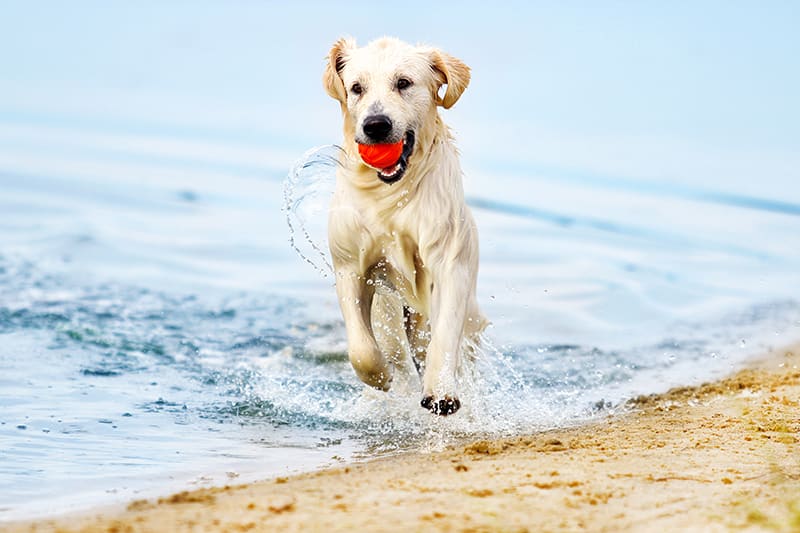Yeast ear infections can be a real problem for dogs living in hot and humid climates - even for just a few brief summer months - but you may be able to help prevent your dog from developing a yeast ear infection. Our Bartlett vets explain how.
Yeast Ear Infections in Dogs
Yeast is a naturally occurring fungi found on your dog's skin and in their ears. When the correct balance of yeast exists your pet's skin and ears stay healthy. However, inflammation of the ear can cause yeast levels to accelerate and grow leading to a brown, greasy discharge within the ear canal and around the inside flap of your pup's ear. This discharge can be both itchy for your pup and smelly.
Our Bartlett vets see yeast infections in dog's ears far more often in the summer months when it is hot and humid than any other time of year. Hot humid weather provides the perfect environment for yeast to grow. When that moisture and warmth are combined with a lack of airflow caused by the shape of your dog's ears, yeast infections can often result.
Causes of Yeast Ear Infection in Dogs
There are numerous reasons why the delicate environment within your pet's ear can be thrown off and result in a yeast infection, some of the most common causes include:
- Trapped moisture - especially in dogs with long floppy ears
- Antibiotics
- Immunodeficiency
- Too much bathing
- Yeast allergy
- Frequent swimming
- Exercise in humid environments
- Feeding your dog sugary snacks
- Not cleaning your dog's ears often enough
Signs of a Yeast Infection in Your Dog's Ear
Yeast ear infections can lead your dog to experience the following symptoms:
- Red or brown waxy discharge in the ear
- Itching, scratching & pawing at the ear
- A cheesy or musty smell coming from the ear
- Red or irritated ear
How to a Cure Yeast Infection in Your Dog's Ears
Ear infections are uncomfortable and itchy for dogs, not only that, they can become painful if the infection is left untreated and becomes more severe.
If you think that your dog may have a yeast infection in one or both ears it's time to head to the vet. Your veterinarian can determine the cause of your pup's ear infection and recommend the best treatment. During your dog's appointment, your vet will likely give your dog's ears a good cleaning to get treatment started off right.
The best treatment for your dog's yeast ear infection will depend upon the underlying cause and may include:
- Regularly cleaning your pet's ears at-home with a medicated cleanser
- Topical medications
- Oral antibiotics
- Anti-inflammatory medications
Preventing Yeast Ear Infections in Dogs
The key to preventing yeast ear infections in dogs is keeping the ear canal healthy and dry.
Whenever your pooch has been in water bathing or swimming be sure to dry your dog's ears well.
Underlying conditions such as allergies or hypothyroidism can cause your dog to experience chronic or recurring infections. Treatment for the underlying cause of your pup's ear infections is essential.
Note: The advice provided in this post is intended for informational purposes and does not constitute medical advice regarding pets. For an accurate diagnosis of your pet's condition, please make an appointment with your vet.
Is your dog showing signs of a yeast ear infection? Early treatment is the key to avoiding further complications from developing. Contact our Bartlett vets to book an examination for your canine companion.

Looking for a vet in Memphis?
We're always accepting new patients, so contact our veterinary hospital today to book your pet's first appointment.Related Articles View All
Heimlich Maneuver For Dogs: What To Do If My Dog Is Choking
What should you do if something gets lodged in your dog's throat and they begin to choke? Here, you will find helpful information on the Heimlich maneuver for dogs and what to do if your dog is choking.
Signs That Your Dog May Have a Cavity
Can dogs get cavities? What are the signs of cavities in dogs? In today's post, you will find the answers to these dog cavity questions and more.
Chipped Tooth in Dogs - What to Do if Your Dog Has a Broken Tooth
Dogs often experience chipped or fractured teeth. Is a broken dog tooth an emergency? It might be. Today's post contains information about broken teeth in dogs and what to do about dog tooth fractures.
Large Dog Care & Saving Money with Wellness Plans
What do large and giant breed dogs need to stay healthy and happy? Here, we provide vital information on how to proactively care for your giant or large dog's health and save money along the way.
